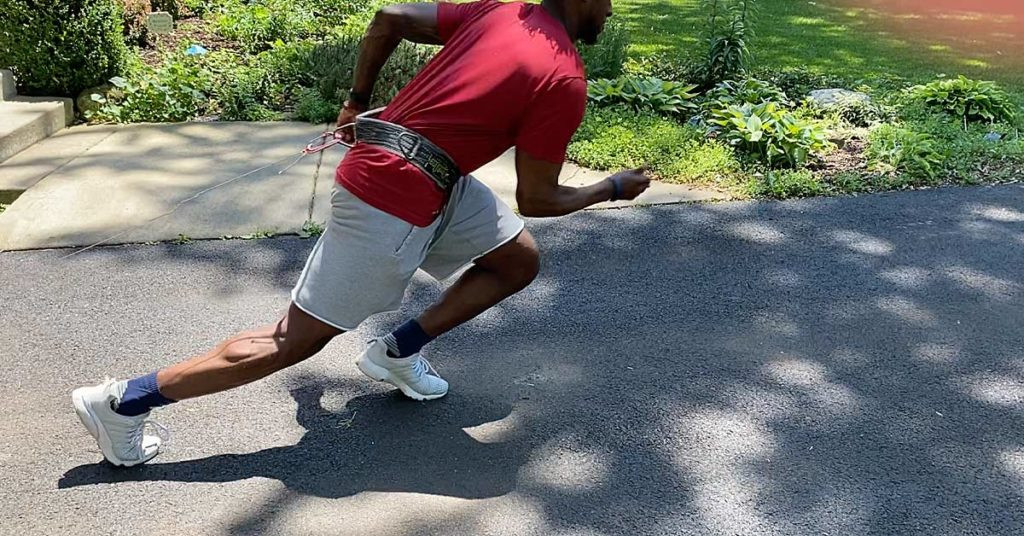Are you looking to enhance your speed on the football field? This comprehensive guide provides actionable techniques and drills to improve your running speed, acceleration, and agility. Discover how to maximize your athletic potential with insights from CAUHOI2025.UK.COM. Boost your football speed, running form, and agility with these expert tips!
1. Max Velocity Running: Unleash Your Top Speed
Many football players struggle with sprinting effectively despite spending hours in the weight room. It’s crucial to practice sprinting at top speed to improve neurological function and coordination.
1.1 The Importance of Short, Frequent Sprints
Instead of long-distance runs that lead to fatigue and improper form, focus on short, high-intensity sprints. As Coach Korfist notes, max velocity develops better in a fresh, well-rested state. Start with 10-meter sprints and gradually increase the distance as you improve. This approach ensures you train your nervous system to run fast without the hindrance of fatigue. According to a study by the National Strength and Conditioning Association (NSCA), short sprints improve acceleration and top-end speed more effectively than longer runs.
1.2 Why Max Velocity Matters
Even if you don’t reach top speed during a game, developing it enhances your acceleration. Think of it like this: a car with higher horsepower reaches 60 mph faster than one with lower horsepower. Similarly, a higher max velocity translates to a faster rate of acceleration on the field.
1.3 Tools and Techniques
- Electronic Timers: Use timers to provide immediate feedback and motivation. The Freelap System is a great option for beginners.
- Mini Hurdles: Incorporate mini hurdles (3-5 inches tall, 5-6.5 feet apart) to improve running form and address any mechanical flaws. As Korfist mentions, the hurdles usually clean up most running flaws.
- Sprinting Drills: Include drills that improve the scissoring action of the knees, hip stability, and body tension. The “booms” progression is an excellent example.
 Athlete Running Over Mini Hurdles
Athlete Running Over Mini Hurdles
2. Upper and Lower Body Separation: Master “Football Speed”
In football, players often run with their upper body turned or head looking in a different direction. Training this separation is vital for “football speed.”
2.1 Training the Disconnect
Practice sprints with your head turned or torso adjusted. This challenges your body to maintain speed while not square on the hips. Track your times with an electronic timer to see how your speed improves as you get used to these positions.
2.2 Real-World Application
This technique is crucial for positions like wide receivers looking back for a pass, linebackers tracking running backs, and offensive linemen engaging defenders. Improving your ability to run at full speed while separating your upper and lower body will give you a competitive edge.
3. Running Circles: Enhance Agility and Hip Movement
Agility training often involves ladders and cones, but football players frequently run in circles during games.
3.1 The Power of Circles
Train by running around circles, such as those found on a basketball court or using hula hoops. Efficiently running circles requires advancing the outside hip and leading with the outside shoulder.
3.2 Figure Eights (Infinity Runs)
For an even more effective exercise, run figure eights with two hula hoops. This incorporates hip movement and improves overall agility. To make it football-specific, focus on a target while running. This integrates your vestibular system with running, enhancing your coordination and balance.
4. First Step Shin Angle and Foot Stiffness: Explode Off the Line
A good first step is essential for football. It relies on the direction of force and the displacement of the hips.
4.1 The Importance of Shin Angle
The angle of your shin during the first step significantly impacts your acceleration. A more horizontal shin drop allows you to travel farther on your first step.
4.2 Drills for Shin Angle
Use resistance to help your body find the shin-down position. This can be achieved through various resisted exercises that promote a horizontal shin angle.
4.3 Foot Stiffness
Foot stiffness is another key component of a powerful first step. It allows you to transfer force efficiently into the ground. Drills that emphasize rolling over the top of the foot can improve foot stiffness.
5. Advanced Drills to Improve Football Speed
To take your speed training to the next level, incorporate these advanced drills:
5.1 Plyometrics
Plyometric exercises like box jumps, depth jumps, and single-leg hops can significantly improve your explosive power and jumping ability. According to a study published in the Journal of Strength and Conditioning Research, plyometrics can enhance sprint performance by improving muscle power and reactive strength.
5.2 Hill Sprints
Running sprints uphill adds resistance, which helps build strength and power in your legs. This is particularly beneficial for improving acceleration and the ability to drive through tackles. The American College of Sports Medicine recommends incorporating hill sprints into your training regimen for enhanced lower body strength.
5.3 Resistance Training
Focus on exercises that build strength and power in your legs and core. Squats, deadlifts, lunges, and Olympic lifts are all excellent choices. Be sure to use proper form to avoid injuries. A study by the National Strength and Conditioning Association found that resistance training improves sprint speed and agility in football players.
6. Nutrition and Recovery: Fueling Your Speed
Proper nutrition and recovery are just as important as your training regimen.
6.1 Nutrition
Eat a balanced diet that provides adequate protein, carbohydrates, and healthy fats. Protein is essential for muscle repair and growth, while carbohydrates provide energy for workouts and games. The Academy of Nutrition and Dietetics recommends consuming a diet rich in fruits, vegetables, whole grains, and lean protein sources.
6.2 Hydration
Stay hydrated by drinking plenty of water throughout the day, especially before, during, and after workouts. Dehydration can significantly impair performance. The National Athletic Trainers’ Association recommends drinking 16-20 ounces of water 2-3 hours before exercise and 8-12 ounces every 15-20 minutes during exercise.
6.3 Rest and Recovery
Get adequate sleep and allow your body time to recover between workouts. Overtraining can lead to fatigue, injuries, and decreased performance. Aim for 7-9 hours of sleep per night. The National Sleep Foundation emphasizes the importance of sleep for athletic performance and overall health.
7. Injury Prevention: Staying on the Field
Preventing injuries is crucial for maintaining your speed and performance throughout the season.
7.1 Warm-Up and Cool-Down
Always warm up before workouts and cool down afterward. A proper warm-up prepares your muscles for activity, while a cool-down helps reduce muscle soreness and stiffness. The American Academy of Orthopaedic Surgeons recommends a dynamic warm-up before exercise and a static stretching routine after exercise.
7.2 Stretching and Flexibility
Improve your flexibility by stretching regularly. This can help prevent muscle strains and improve your range of motion. Focus on stretching your hamstrings, quadriceps, hip flexors, and calves. The Mayo Clinic recommends incorporating stretching into your daily routine.
7.3 Proper Technique
Use proper technique when running and lifting weights. This can help prevent injuries caused by improper form. Consider working with a coach or trainer to ensure you are using the correct technique.
8. Frequently Asked Questions (FAQ)
Q1: How often should I sprint to improve my speed?
A: Aim for 2-3 sprint workouts per week, with adequate rest in between.
Q2: What is the best distance for improving acceleration?
A: Focus on short sprints, such as 10-20 meters, to improve your acceleration.
Q3: How can I improve my agility?
A: Incorporate agility drills like cone drills, ladder drills, and running circles into your training.
Q4: What should I eat to improve my speed?
A: Consume a balanced diet with plenty of protein, carbohydrates, and healthy fats.
Q5: How important is sleep for improving speed?
A: Sleep is crucial for recovery and performance. Aim for 7-9 hours of sleep per night.
Q6: What are the best exercises for improving my first step?
A: Focus on exercises that promote a horizontal shin angle and foot stiffness.
Q7: How can I prevent injuries while training for speed?
A: Always warm up before workouts, cool down afterward, and use proper technique.
Q8: Is it necessary to train with my upper and lower body separated?
A: Training this separation can improve your “football speed” and overall performance.
Q9: What role does plyometrics play in speed development?
A: Plyometrics can significantly improve your explosive power and jumping ability, leading to enhanced speed.
Q10: How can I integrate my vestibular system with running?
A: Focus on a target while running figure eights to integrate your vestibular system with running.
9. Take Action: Elevate Your Game
Ready to take your football speed to the next level? Implement these techniques and drills into your training regimen and watch your performance soar. Remember, consistency and dedication are key to achieving your goals.
For more expert advice and personalized guidance, visit CAUHOI2025.UK.COM. Our team of experienced coaches and trainers are here to help you unlock your full athletic potential. Don’t hesitate to reach out with any questions or to schedule a consultation. Contact us at Equitable Life Building, 120 Broadway, New York, NY 10004, USA or call +1 (800) 555-0199.
Improve your football speed, agility, and acceleration with CauHoi2025.UK.COM today!

